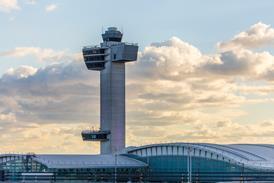Tim Ripley
Britain's Defence Evaluation and Research Agency (DERA) has been selected to conduct further trials in advanced Short Take Off Vertical Landing (STOVL) control law development for shipboard operations.
The $2.5-million year-long contract was finalised in early February and is collaboratively funded by the the American/UK Joint Strike Fighter (JSF) programme office and DERA.
The study will use the agency's Vectored-thrust Aircraft Advanced-flight Control (VAAC) Harrier.
"DERA's VAAC Harrier boasts the most capable system in the world for studying control concepts for powered lift aircraft," says DERA representative Joanna Sale.
"Detailed modifications to its two-seater format has introduced a digital flight control system that offers advanced, programmable fly-by-wire capabilities from the rear seat. The result gives the rear pilot full-authority, digital control of the aircraft allowing programmable computer simulations of different flying modes to be developed and installed. The controls determine the flightpath via a computer interface."
The forthcoming JSF trials will build on prior DERA/National Aeronautics and Space Administration (NASA) research into advanced control laws but will represent the first comprehensive shipboard evaluation.
"DERA is well placed to continue these studies having been the first to achieve a successful fly-by-wire landing of the VAAC Harrier onto the deck HMS Illustrious in September 1999," says Sale.
Advanced
"The timing for this research contract is significant as it will help reduce the risk of the JSF STOVL flight control system development efforts as the programme enters the EMD (Engineering Manufacturing & Design) phase in 2001.
The VAAC Harrier is well known to the JSF programme and has been used for both government and contractual evaluations in the past."
"DERA's VAAC Harrier provides us with a unique test facility," says Col Gene Fraser, Systems Engineering Director for the JSF programme. "DERA will be able to investigate the design options for shipboard control concepts to help reduce STOVL flight control law development risk."
The VAAC Harrier's digital flight control system has three key implications. Firstly it allows the testing of different flying modes in real-flight environments.
Secondly, modifications to the software and the flying experience can be swiftly and easily accommodated between flights with the significant benefit of incorporating pilot feedback practically instantaneously.
Thirdly, it offers STOVL capability without the need for the tricky third nozzle control lever, thus significantly improving flying simplicity.
The use of mechanical detents and computer feedback to lodge the stick and throttle, hold the aircraft at existing speed, bank altitude, climb, dive angle, hover height, side slip direction, descent, ascent etc to give hands-free flying.
"The integrated approach will benefit the JSF programme in a number of ways," says Flt Lt Terry Parker, DERA's VAAC Harrier Test Pilot.
"It offers the capability for simpler, carefree handling to ensure a lower training burden, a reduction in the risk of pilot error so saving lives and airframes and an increase in pilot/airframe performance through the optimal use of controls."
Source: Flight Daily News























